New products at Crocus
by Sarah - December 18th, 2009.Filed under: Crocus, New Products.
Crocus just added loads of new products

Plaited Stem Standard Bay £124.99
Position: full sun or partial shadeSoil: fertile, moist but well-drained soilRate of growth: slow-growing Flowering period: March to May Flower colour: clusters of greenish-yellow flowersOther features: black autumn berries on female plants; contact with the foliage may aggravate skin allergies; the mature leaves may be used fresh or dried in bouquet garni, for flavouring stocks and saucesHardiness: frost hardy (needs winter protection)This evergreen plaited bay laurel standard makes an elegant centrepiece for a formal vegetable garden or potager. Provide a sheltered, sunny or partially shady site and winter stem protection in cold areas. Clippings of the lustrous, aromatic, dark green leaves are valuable, fresh or dried, for flavouring savoury stocks and sauces.Garden care: Keep well-watered during the growing season and feed with a slow-release fertiliser such as Osmacote. Clip established plants lightly twice during the summer months to retain a balanced shape, using secateurs not shears>
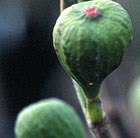
fig £24.99
Position: full sunSoil: will tolerate most soils, except very badly drainedRate of growth: averageOther Features: big, rounded golden violet fruitsHardiness: fully hardyThis deciduous, spreading shrub is highly ornamental, with large, glossy, palmate leaves. It is best grown against a south or south-west facing wall, where, in long, hot summers it will produce an abundant crop of gold/violet, pear-shaped fruit. These figs are big rich & sweet and available for picking from August to September. An interesting and easy plant to grow, and one of the oldest fruits in cultivation. Garden care: Plant in a 40cm (15in) pot in the ground or in a lined pit to restrict root-growth – unrestricted root growth leads to poor fruiting. Prune in spring when all chance of frost has past. Remove any frost-damaged or weak branches, and thin out shoots to let light in. Some pruning may be required in summer – trim all new shoots back to five or six leaves.Figs are capable of producing three crops of fruit every year, but in our climate it is the little tiny ones that you find tucked into the leaf axils in autumn that will go on to ripen in their second summer. Therefore, on smaller trees (and larger ones where you can reach), you should remove any developing fruits that are larger than a pea in autumn, as these usually never amount to anything and generally rot over the winter. This will help direct the plants energy into pushing the young fruits to become tasty, fully ripened figs next year.

tree peony / tree paeony £19.99
Position: full sun or partial shadeSoil: fertile, moisture-retentive yet well-drainedRate of growth: vigorousFlowering period: April to MayHardiness: fully hardyTree peonies, the Chinese national flower, are enjoying a revival. Prized for their blowsy, glamourous blooms and glossy, deeply cut foliage, peonies are held in deep affection by many gardeners, despite their short flowering season and vulnerability to peony wilt in damp weather. It’s easy to see why. In late spring or early summer, this tree or shrub peony has huge, frilly, lavender-pink, sometimes scented, semi-double flowers set among deeply cut, dark green leaves. The flowers, up to 15cm/6in across, make a fabulous feature in a sunny, protected border. If you are placing it in a border or a lawn, try planting early spring bulbs around the base to prolong the season of interest.Garden care: Protect from cold winds and early morning sun. Support the branches of young shrubs with canes to prevent the massive flowerheads from being battered by rain. Tree peonies are hungry feeders, so ensure that container-grown specimens receive a top-dressing of a slow-release fertiliser in spring. In the border apply a top-dressing of a balanced, slow-release fertiliser around the base of the plant in early spring and mulch with well-rotted garden compost or manure. If the plant shows signs of collapse or the leaves become spotty, this may be a symptom of peony botrytis. Remove affected leaves immediately. In the autumn, cut off all of the foliage and dispose of it to avoid reinfection the following spring. The older stems of tree peonies have a tendency to become brittle and snap, so cut these back to the ground in autumn every two or three years.

tree peony / tree paeony £19.99
Position: full sun or partial shadeSoil: fertile, moisture-retentive yet well-drainedRate of growth: vigorousFlowering period: April to MayHardiness: fully hardyTree peonies, the Chinese national flower, are enjoying a revival. Prized for their blowsy, glamourous blooms and glossy, deeply cut foliage, peonies are held in deep affection by many gardeners, despite their short flowering season and vulnerability to peony wilt in damp weather. It’s easy to see why. This tree or shrub peony erupts with fiery red, sometimes scented, semi-double flowers in late spring and early summer. With its handsome, deeply cut foliage and vivid, enormous flowers, it makes a stunning focal plant for a sunny border. Try planting early spring bulbs around the base to prolong the season of interest.Garden care: Protect from cold winds and early morning sun. Support the branches of young shrubs with canes to prevent the massive flowerheads from being battered by rain. Tree peonies are hungry feeders, so ensure that container-grown specimens receive a top-dressing of a slow-release fertiliser in spring. In the border apply a top-dressing of a balanced, slow-release fertiliser around the base of the plant in early spring and mulch with well-rotted garden compost or manure. If the plant shows signs of collapse or the leaves become spotty, this may be a symptom of peony botrytis. Remove affected leaves immediately. In the autumn, cut off all of the foliage and dispose of it to avoid reinfection the following spring. The older stems of tree peonies have a tendency to become brittle and snap, so cut these back to the ground in autumn every two or three years.
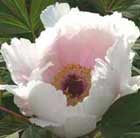
tree peony / tree paeony £19.99
Position: full sun or partial shadeSoil: fertile, moisture-retentive yet well-drainedRate of growth: vigorousFlowering period: April to MayHardiness: fully hardyTree peonies, the Chinese national flower, are enjoying a revival. Prized for their blowsy, glamourous blooms and glossy, deeply cut foliage, peonies are held in deep affection by many gardeners, despite their short flowering season and vulnerability to peony wilt in damp weather. It’s easy to see why. In late spring or early summer, this tree or shrub peony produces gorgeous, pale pink, sometimes scented, semi-double flowers set among dark green leaves. With its blowsy, delicate-coloured flowers, this variety looks particularly good as part of a cottage-garden scheme. If you are placing it in a border or lawn, trying planting early spring bulbs around the base to prolong the season of interest.Garden care: Protect from cold winds and early morning sun. Support the branches of young shrubs with canes to prevent the massive flowerheads from being battered by rain. Tree peonies are hungry feeders, so ensure that container-grown specimens receive a top-dressing of a slow-release fertiliser in spring. In the border apply a top-dressing of a balanced, slow-release fertiliser around the base of the plant in early spring and mulch with well-rotted garden compost or manure. If the plant shows signs of collapse or the leaves become spotty, this may be a symptom of peony botrytis. Remove affected leaves immediately. In the autumn, cut off all of the foliage and dispose of it to avoid reinfection the following spring. The older stems of tree peonies have a tendency to become brittle and snap, so cut these back to the ground in autumn every two or three years.
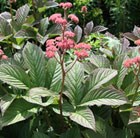
rodgersia £12.99
Position: full sun or partial shadeSoil: humus-rich, moist soilRate of growth: slow-to-establish Flowering period: July and August Flower colour: pinkOther features: attractive pink-tinted seed-headHardiness: fully hardySpikes of bright-pink, star-shaped flowers on dark-red stems in mid- and late summer above deeply divided, dark green leaves, purplish-bronze when young. This award-winning rodgersia is perfect for the moist margins of a pond or stream. Best grown in a sheltered, partially shady site, it contrasts well with the lacy-textured foliage of regal or shuttlecock ferns.Garden care: Add lots of well-rotted leaf mould when planting. Protect the young foliage against slug damage using beer traps or environmentally friendly slug pellets. Lift and divide congested colonies in early spring.
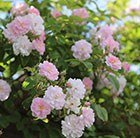
rose Paul’s Himalayan Musk (rambler) £10.99
Position: full sunSoil: fertile, humus-rich, moist, well-drained soilRate of growth: fast-growing Flowering period: June to August Flower colour: pale pinkHardiness: fully hardyLarge clusters of rosette-shaped, double, pale pink flowers are borne freely in summer. One of the best and most beautiful of ramblers, it is ideal for growing into a tree, over a pergola, or over any other support. It is rampant but the long, trailing branches up to 30ft that are covered in dainty, heavily scented roses is well worth it.Garden care: Before planting shorten thick roots to 25cm (10in) and reduce top-growth to an outward-facing bud 20-30cm (8-12in) above ground-level. Plant during a frost-free spell, incorporating well-rotted organic matter and a balanced fertiliser into the planting hole. Ensure that the ‘bud union’ (the bulge at the base of the shoots) is 2.5cm (1in) below the soil.All our roses are field grown. In October/November they are dug up and potted. However, they will not produce any new roots until spring, so don’t be surprised if the compost falls away from the roots when winter planting. Some suppliers send out ‘bare root’ plants unpotted, but we don’t as it is easier to manage them on the nursery in pots.
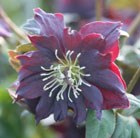
hellebore £10.99
Position: partial shadeSoil: heavy, neutral to alkaline soil, including heavy soilRate of growth: average Flowering period: February to AprilHardiness: fully hardy (borderline)Nodding or outward facing, double, deep purple-black flowers open in February and last for up to three months. The handsome evergreen foliage is leathery, deeply cut and dark green. This is a new variety of lenten rose and the flower colour is extremely unusual. The deep purple-black double flowers have creamy-yellow centres and look stunning contrasted with snowdrops. To appreciate their colour, they are best planted in groups at the front of a partially shady mixed border or as ground cover for areas of dappled shade under deciduous trees amd shrubs. In former times, hellebores were planted close to cottage doors to prevent evil spirits from crossing the threshold.Garden care: A top tip from the Crocus crew is to cut back the old leaves to the ground in January or February. This will show off the emerging flowers to best effect and it also helps to get rid of foliar diseases such as hellebore leaf spot. When planting, add lots of well-rotted leaf mould or organic matter to the planting hole. Apply a generous 5-7cm (2-3in) mulch of well-rotted organic matter around the base of the plant in autumn and provide a top-dressing of general fertiliser each spring.
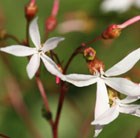
Bowman’s Root £9.99
A pretty perennial that bears masses of irregularly star-shaped white flowers from late spring to late summer. In autumn the foliage turns fiery red and the winter seedheads are a bonus too. Ideal for growing as a cut flower.Position: partial shadeSoil: fertile, well-drained soil, neutral to slightly acidic soilRate of growth: averageFlowering period: May to AugustFlower colour: whiteHardiness: fully hardyGarden care: Divide congested plants in spring or autumn. Protect young shoots from slug attack
clematis (group 2) £8.99
Snowdrop anemone £7.99
switch grass £7.99
bearded iris £6.99
dusky cranesbill £6.49






